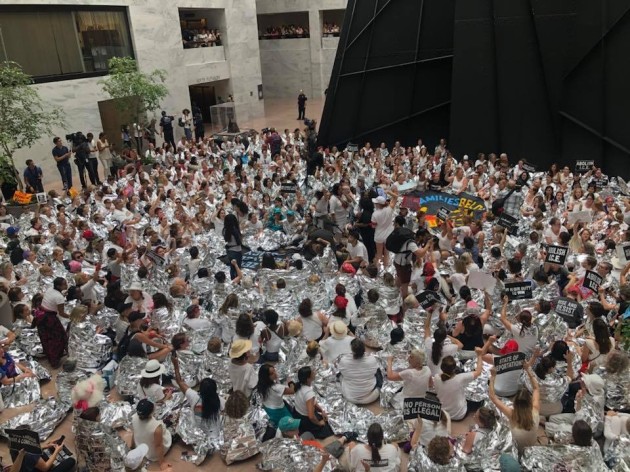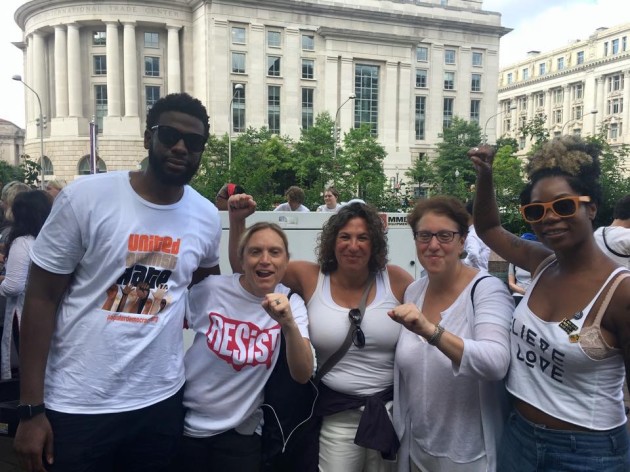The Lilith Blog 1 of 2
July 20, 2018 by Eleanor J. Bader
Marilyn Sneiderman on Finding Optimism and a Life of Labor Organizing

“You have to be an eternal optimist to be a community and labor organizer,” Marilyn Sneiderman, Executive Director of the Center for Innovation in Worker Organization, says with a laugh. “You have to believe social change and social justice are not just some distant hope, but are something we can win through our day- to-day organizing and vision of a more just world.”
Sneiderman spoke to Eleanor J. Bader several days after she was arrested—along with more than 600 women from throughout the country—at a sit-in at the Hart Senate Office Building in Washington, DC. The action was called to protest the family separation and incarceration policies of US Immigration and Customs Enforcement (ICE).
“It was incredible to see so many women come out and challenge injustice, some by getting arrested for the first time,” Sneiderman says. “It’s this kind of action that keeps me inspired—to see people take steps to really challenge injustice in a concrete way. Sometimes the best way to stand for justice is to sit, or sit-in, in the halls of power.”
During the course of an hour-plus phone conversation, Sneiderman and Bader discussed a wide range of topics, from the veteran organizers’ personal history, to the roles Judaism and feminism have played in her more than 30-year career as a labor organizer, educator, and activist.
Eleanor J. Bader: You grew up in Erie, Pennsylvania in the Rust Belt. How did that shape you?
Marilyn Sneiderman: My family was part of a small, tight-knit, Jewish community and being Jewish was at times an incredible challenge. We kept a kosher home and I attended Hebrew school, Sunday school, and Shabbat services, so I always knew I was different from most of the other kids. By seventh grade I faced direct anti-Semitism when some kids threatened to beat the shit out of me for being Jewish.
Growing up this way was really different from the experience of friends who grew up in New York City or in other hubs of Jewish life. It wasn’t always easy, but it made Judaism more real for me. Instead of scaring me, experiencing anti-Semitism sensitized me to what it feels like to be sidelined, stereotyped, and an outsider.
When Dr. Martin Luther King was murdered, there were riots in Erie and incredible racial tensions in my public school. The combination of all of this influenced my developing political consciousness. For me, race, class, and gender justice became wrapped in the fabric of being a Jew and are core to my identity.
EB: At the same time, you’ve pushed back on restrictions within Judaism.
MS: When I was growing up, women could not have an Aliyah or count in a minyan at our conservative synagogue. Even then, I fought back. I kept running for leadership positions in the youth group, led prayers from the bimah, and organized to change the role of women in our synagogue. I had an uncle who was flipped out about my wearing pants to shul during one of Erie’s famous snowstorms but I am proud to have been a leader in this effort. During this period—junior and senior high school—I was also going to marches against the Vietnam War.
EJB: Did you continue to pursue activism when you left home?
MS: After high school, I thought I wanted to be an international diplomat and I got an incredible scholarship to attend the Georgetown University School of Foreign Service. It was very preppy, very upper class, and conservative. After a year and two weeks I took a leave, bought an Ameripass, and traveled around the country. When I got to Madison, Wisconsin, I was energized and inspired by a world I had never experienced before-It was a long way from Erie! The university offered women’s studies classes, there were a lot of vegetarian restaurants, and everywhere I looked I saw political posters.
EJB:How did you get involved with the labor movement?
MS: I got a job in Madison as a typist at the State’s Department of Labor, and it was my first engagement in the labor movement. It was also a lesson in how women were being treated in the workplace. For example, almost all of the exterior offices were filled with white men, while women were in tiny cubicles on the inside of the room. I thought this was wrong. Many of these women had been there for years, knew the research inside and out, and trained the men taking the analyst positions. But they could not become analysts themselves without a college degree.
I began organizing to alter that system. I became Shop Steward in the American Federation of State, County, and Municipal Employees (AFSCME) Local 145 and advocated for the creation of a secretarial career ladder, so that women without college degrees could advance. I also recall going to a Central Labor Council meeting with another woman to bring my local union more into the broader labor movement, and basically getting treated as if we had no right to be there. I remember thinking I wanted to get more women involved. Thankfully, because of our union contract, I was able to take classes and complete my degree. I eventually got a Masters in Social Work, with a focus on community organizing and women’s studies, from the University of Wisconsin-Madison.
EJB: How did you get your first job with a union?
MS: It was sheer chutzpah! I told union officials that I wanted to put together a community organizing program for AFSCME and was initially brought in as an intern. It was 1982 and I was hired as a staff person fairly quickly. I worked on a campaign in Portsmouth, Ohio, to stop the privatization of a long-term care facility. It was my first exposure to the importance of building community-labor alliances; after we brought clergy and community people in as partners with the union, we won!
EJB: Since then, you’ve had major positions at the Teamsters and the AFL-CIO.
MS: In 1991, the late Ron Carey was elected President of the Teamsters as an insurgent. I wanted to be part of this, wanted to be part of the movement to democratize the largest union in North America; I became the union’s Education Director. In this capacity, I traveled all over the US and Canada and greatly expanded the union’s educational outreach. Then, in 1995, John Sweeney became head of the AFL-CIO and he asked me to head the Field Mobilization Department. It felt like a change-the-world moment and I was very excited about it. I was the first woman to lead the largest department of the federation and we spearheaded the strategy of bringing unions and community groups together to transform and build progressive movements throughout the country It was an extraordinarily exciting time
EJB: How did you pivot into Jewish-social justice work with AVODAH, the Jewish Service Corps?
I left the union in 2005 and thanks to an incredible group of women—led by my friend Ruth Messinger of the American Jewish World Service—I learned the nuts and bolts of managing and directing a progressive non-profit. I had never done this before and was able to bring my community /union organizing spirit into AVODAH. I loved the passion and growing political consciousness and activism of the young people involved in AVODAH. Despite that, after four years I realized that my heart and soul were still in the labor movement. When I met with Rutgers labor faculty, I told them that I wanted to set up a center to strategize how and where the labor movement needed to move forward. We’ve since built the Center for Innovation in Worker Organization together, out of nothing. It is still growing.
EJB: Can you describe some of the Center’s projects?
MS: One program I am very excited about is called Building the Bench. We’ve pulled together about 25 organizations—the Center for Popular Democracy, Jobs with Justice, The National Domestic Workers Union, The Restaurant Opportunity Center, The Gamaliel National Network, among them. The purpose is to bring managing directors and staff together to share strategies for strengthening their organizing work and build relationships across fields. We’re encouraging cooperation over competition and are sharing ideas for base building so that organizations are less dependent on foundations. Additionally, thanks to a grant from the Berger-Marks Foundation, we’re working with the Kalmanovitz initiative for Labor and the Working Poor at Georgetown University to build an innovative, multi-dimensional women’s leadership program with a strong racial lens.
EJB: What do you think the long-term impact of the anti-labor Janus decision will be?
MS: Obviously, Janus was a terrible decision. But, It is incredibly important to realize that labor has been under attack legislatively, by the courts and corporations, since the passage of Taft Hartley in the 1940’s. Janus is a continuation of a larger right-wing agenda that has escalated in recent years, whose goal is to destroy unions, redistribute wealth and power to the super rich, and upend democracy. Janus makes it clear that we have to reimagine the role of unions and how we contest for power—both at the work site and in society more broadly.
Labor has to change and an increasing number of unions know this. Many are increasingly bargaining for the common good–programs that benefit specific workers and entire communities. I see a lot of potential in union-community alliances. The teacher walkouts this spring are a good example. These folks were totally fed up and said, ‘Life has to change.’ It was not only about wages and benefits, but was about what teachers, students, parents, local residents and an array of business leaders, clergy, and people working in healthcare and social service agencies wanted their schools to look like. By aligning with others and forming broad-based coalitions and partnerships, some great victories were won, not just for the teachers’ unions, but for whole communities.
I’m actually more optimistic than ever about bargaining for the common good and see community-union alignments as the playbook going forward.
EJB: Still, we’re in a period of almost unprecedented backlash, with resurgent racism, sexism, anti-Semitism, and anti-immigrant sentiments being explicitly articulated and acted upon. How do you stay so upbeat?
MS: I surround myself with young idealistic people who believe that we can and must change the world. I do a lot of coaching, but the young people I interact with also coach me. The best thing we can do is stay intergenerationally focused and listen to the ideas of today’s young activists. The challenge is to learn from the past, identify what worked, build on it, and at the same time avoid shutting down new ideas based on past failures.
We also can’t lose sight of the fact that there are a lot of incredible organizers out there doing fantastic work. The question for me is how we older people can best support them. The last few weeks have been incredible—there have been so many protests in support of immigrants, calls to abolish ICE, and rallies against Janus. All of this is inspiring to me. Then again, people have called me an eternal optimist—which I think is true!

 Please wait...
Please wait...